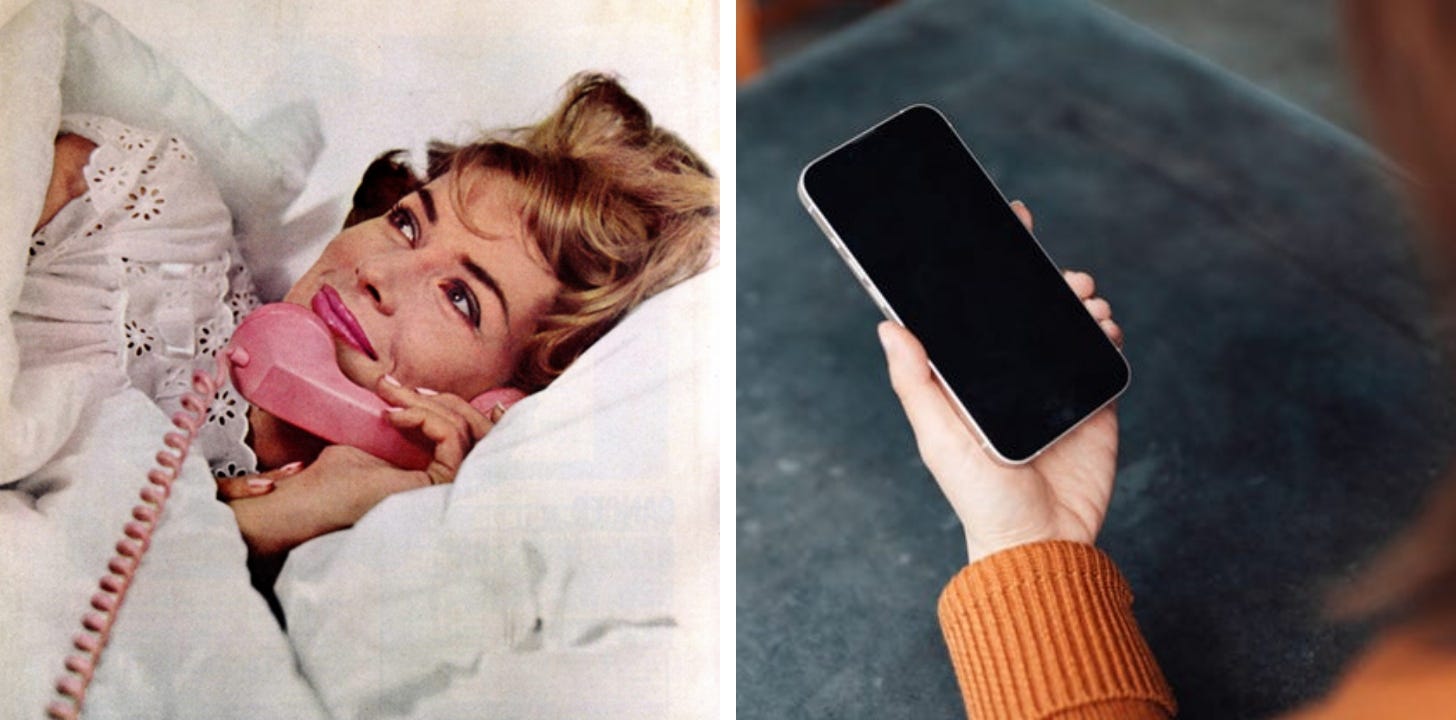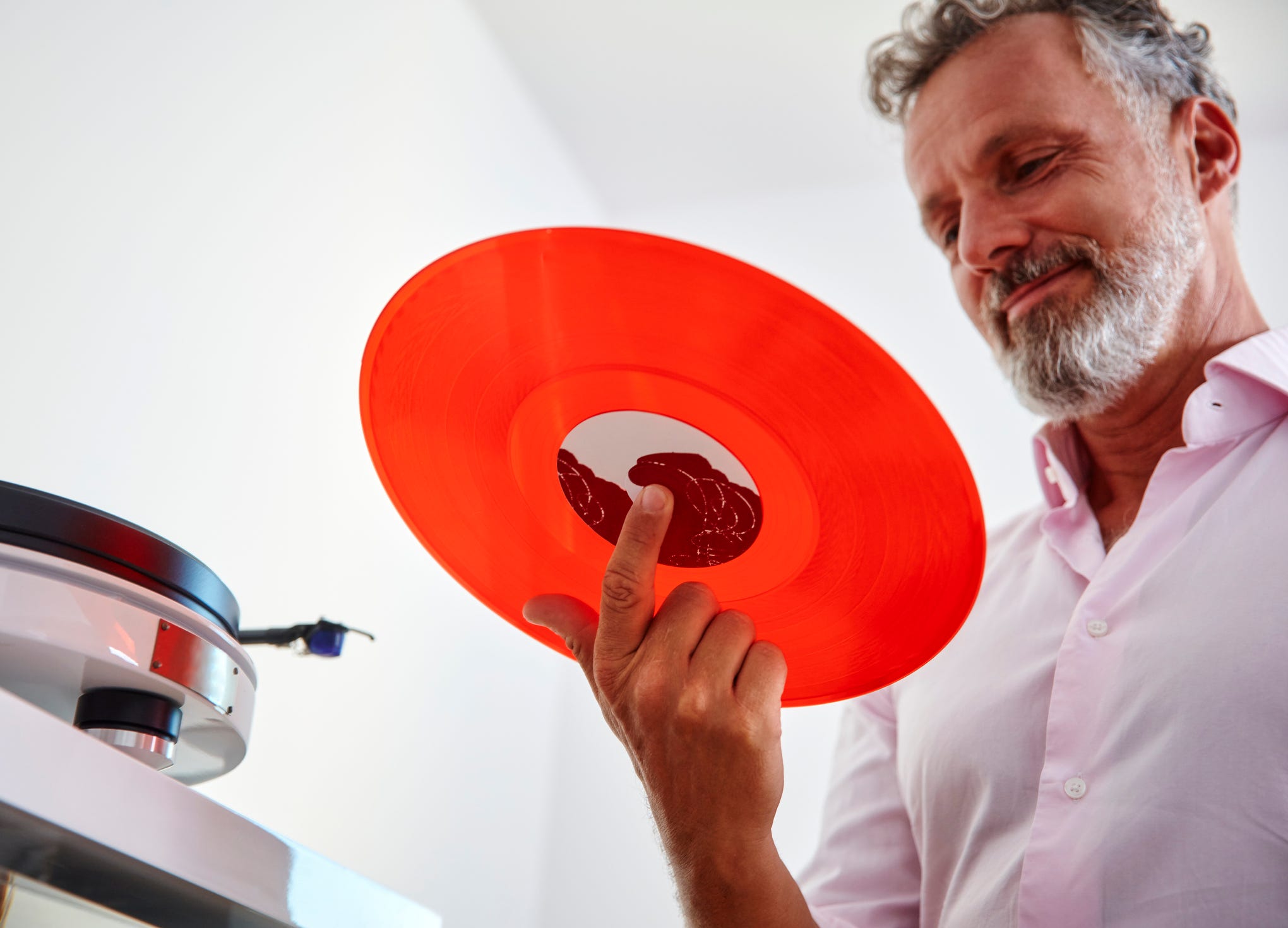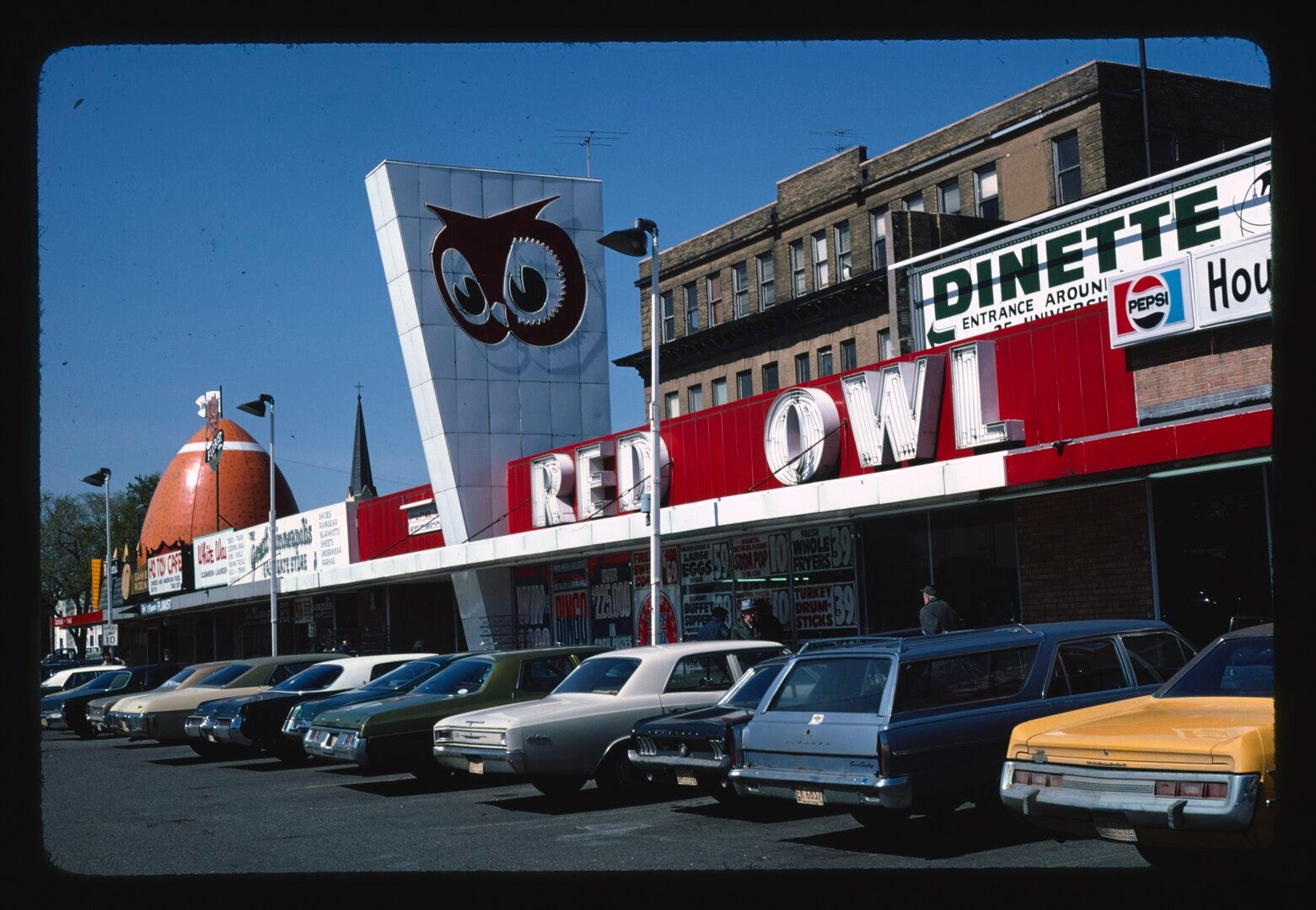|
 |
The other day at the grocery store, I saw an old friend, and he looked just as mad as ever. Perhaps I misread his expression, but it was furrowed with concentration, glaring at me, impatient. Even so, when he started disappearing about 30 years ago, everyone missed him.
He was a logo: the Red Owl, the symbol of a grocery chain once common in Midwestern cities. I have a T-shirt with the logo, and I can’t wear it without getting stopped by someone in the post-50 demographic. Thumbs up. Love the Owl. Miss the Owl.
The neighborhood grocery store was celebrating its 40th anniversary, so they brought back the logo. The cashiers, the bag boys, the butchers—all wore T-shirts with the glaring owl. I loved it. But here’s the interesting part: The store for which we had such sudden and sodden nostalgia was, in almost every way, inferior to the grocery stores of today.
What exactly were we nostalgic for?
Things Are Easier. Are They Better?
Nostalgia can be triggered by old things no longer in use. Logos. Tools. Consider the old silver metal ice cube tray. A miserable thing. You pulled the lever, and—no, sorry, first you chopped it out of a furry ice cave, trying not to hit the freon line, and then you pulled the lever, and because you got frost on your hand, the frozen metal of the handle adhered to your wet hand and took off some skin. The lever released about six intact cubes and made ice hash of the rest. Then you refilled the tray and put it back in, sloshing some water in the process and guaranteeing it would be frozen to the interior again.
Today, you push a button on the front of the fridge, and magical perfect ice clatters into your glass.
Nevertheless, the ice cube tray triggers nostalgia. Why? Not because it’s better. It’s worse in every way. It just brings back a set of memories from when you were small and happy and generally clueless, and it was a hot day and mom made Kool-Aid. That’s it. But that’s enough to make you pick one up at a garage sale and think about it for a few seconds, and smile: I remember this.
It’s possible we smile at the ice cube tray because it confirms our opinion of the Golden Past: Everything was a little more difficult, but we were better for it. Instant, infinite ice is decadent and has made us soft—we’ve come to expect perfect ice at the literal touch of a button, with no effort on our part. Our phones connect us instantly to the other side of the world for pennies, but oh, in the old days when you dialed a number, you really dialed a number, and the heft of the receiver had a significant solidity that made the phone call seem more important. Why, you could knock someone unconscious with an old receiver. Try that with your iPhone.
Our cars alert us when we stray out of our lane and gently guide us back between the lines. They pull music from satellites in space. But those sheet-metal boats of the ’50s, those were better. Our TVs are big and bright and sharp, but we sigh when we see the space-age design of a Philco Predicta or the bourgeois stolidity of a console set with the record player built in.
Our phones have access to every song ever recorded, and we can create endless playlists with a few vocal remarks to the robot lady who lives in the cloud, but we get misty over the days of owning vinyl albums. Indeed, the very sound of the needle finding the grooves seems like the sound of the gates of paradise opening again. Is it any wonder that vinyl is now the most popular physical music format for the first time in decades?
I think these things are all rather silly, but they’re understandable. There’s wisdom in these sentiments. And a danger.
Boring and Interchangeable … and Lost
Perhaps we just miss good design. We love old cars because they had color and swoops and fins and bulbous protrusions and chrome galore. Never mind if the steering column would spear your sternum like a ripe olive if you went head-on into a telephone pole—the old designs were about freedom, power, speed, money, sex and fun. Today’s cars are mostly boring and interchangeable.
The old TVs wanted to be furniture, so they dressed up. Or they wanted to point to a big, wide future, so they looked modern, like terminals in a spaceship. All TVs now are black and thin. Boring and interchangeable.
The rise and ubiquity of the cellphone is the most significant consumer development in the last quarter-century, but they’re mostly the same. The old phone on the wall or the desk models looked like nothing else in the house. Drop your phone today, and the glass shatters. An old phone? You could hang up so hard that it stirred the bones of Alexander Graham Bell and the set could take it.

Not all design was top notch. We laud the best and forget how wood-grained plastic infected everything from Mr. Coffee machines to automobile dashboards. (As the quote goes, the only proper use for wood-grained plastic is the coffin for the man who invented wood-grained plastic.) But at least design was constantly changing, reflecting and shaping new moods. This all seems to have stopped. No new paradigms in audio receivers because we don’t have them anymore. No new design in portable cassette players, for the same reason. No stylistic shifts in typewriters. Back in 1999, Apple brought out plastic clamshell laptops in various colors with milky white keys—they were playful and fun. The closest Apple gets now are the different hues of the iMac, which is mostly glass anyway.
We don’t see new design styles in magazines because we don’t read magazines anymore. Print ads are dead. Web ads look alike. Websites look alike. Think of the last 20 websites you visited, and compare them to the memory of a newsstand in 1996, with a hundred covers competing for your attention.
Old logos like Pepsi’s and Pizza Hut’s are coming back! Burger King’s TV ads use the old ’70s hues! Boomer accounts on Facebook wallow in remember-when posts about what a great golden age we’ve lost—a time that somehow always seems to occur between the ages of 5 and 15. But it’s not just boomers. You’ll see news stories here and there that point to a new wave of nostalgia, as the boomers age out and the younger generations, sliding toward middle age, look back for some handholds. Millennials on YouTube get the weepy feels about the cartoons of their youth. Everything used to be better! Why, when I was 7 years old, in September 2001, everything was awesome!
That’s part of the nostalgic urge, and it’s healthy: It’s good to be interested in other eras, how they looked, why things looked the way they did, what it all meant. (Really, it meant they wanted to sell you soap and watch Milton Berle.) What’s not healthy is imposing some narrative of uniform cultural solidity on the past based on memories and YouTube compilations of old commercials. Boohooing about the loss of a common culture—three networks, Time and Newsweek and Life, the daily paper, the movies, Paul Harvey every noon saluting his fellow Americans—saps one’s desire to make something good of our times and the times to come, because what’s the point?
Disclosure: I’m talking to the mirror. When it comes to nostalgia, to inventing a past out of ads, songs, toy catalogs, 1946 kitchen remodeling pamphlets, 1939 World’s Fair brochures and 1960s chrome motel postcards, I’m the worst. I spend 10 minutes on the newspaper of the day and an hour in the newspapers of the past. (And I work for a newspaper.) I freeze-frame old movies and get verklempt over the background views of city life, with the bustling sidewalks, neon signs and variegated storefronts.
There was so much that was better, and it’d be foolish not to want to spend time studying the particulars of the American past. The way people seemed to dress and act like adults, the pre-burb vitality of downtowns, the shared culture that made up the unique American atmosphere inhaled by all—for all the bad press the 20th century gets, we really did build something remarkable. Now we can’t put on a great hopeful world’s fair, build a railway, sell a hundred thousand copies of a newspaper crammed with stories and ads big and small for everything from furniture and shoes to lumbago cures to and milk. We’ve lost the plot; we’ve lost the knack, and we all know it on one level or another.
And it makes you mad. At some level, nostalgia makes you mad.
Compounding the problem is the Year Zero utopianism of the modern Left, which regards the past as a vast abattoir of perfidious “-isms.” Praise a cathedral on X-Twitter, and they’ll bring up ephebophiliac priests. Laud the style of a 19th century English gentleman, and you’ll hear the litany of colonial injustices. The Left suspects anyone who admires the works of a previous era because they must be secret Klansmen who are using the superiority of Bernini over modern sculpture to make a case against the entirety of modernity. Oh, you may say they prefer the architecture of St. Peter’s over a 1960s football stadium, but what you really mean is women shouldn’t work and gays should live in the shadows.
Yeah, that’s it, pal. Nailed it. When I say that Moderne skyscrapers of the ’20s and ’30s were, on the whole, superior to endless iterations of Miesian boxes, it’s an Ayn Rand-ian, fascist dog whistle.
The Left has its own sort of nostalgia. It’s dreary and doctrinaire, grounded in granola-boomer mythos about the ’60s. But this nostalgia is dying: Today’s young people don’t care about the era, and they don’t care to know. Really, everything began a few years ago, nothing preceded it, so there’s nothing to learn. There’s just the terrible imperative of NOW, when we have about six minutes to adjust the planet’s climate and defeat the wave of freshly pressed Nazis that threaten Our Democracy. (They’re here, everywhere, but somehow oddly unseen.) So their nostalgia centers around video games and TV programs. It’s odd how they’re never confronted on that: Oh, so you get nostalgic for booting up LimeWire or Napster to steal some songs? Funny how you like that era when gays couldn’t marry.
Pining for a Golden Age, Again and Again
This backward-looking regret may be a result of some of our best attributes: dynamism, reinvention, a revolutionary spirit. We have always been confident we could make a better tomorrow, and we’ve usually been correct. Unlike Bolsheviks and Jacobites, we do not require the destruction of the old and the total imposition of the new. We poke holes in walls and build doors to the other side, but we’re sane enough to linger on the threshold and look back before we cross.
We have a nagging feeling that our urge for reinvention makes us lose something we’ll regret when it’s gone. The newspapers of the ’20s, an era of astonishing energy and sophistication, are full of laments for the loss of the old ways. The ads of the ’30s had amused affection for the Gay ’90s. Simon and Garfunkel wondered where Joe DiMaggio had gone. Tony Soprano was haunted by the fact that he’d come in at the end of something. Every American era will be reviled as it unfolds and admired when it is over.
The difference now is that we’ve stopped evolving and entered a remix culture, where the vast past is just a thrift store of costumes and artifacts, consumed in solitude through glowing glass rectangles, shared in an incorporeal community where avatars speak in unpunctuated text, memes and algorithmically selected TikTok moments. It’s a level of hell Dante never named, the one populated entirely by willing volunteers.
But don’t despair. There’s a lot that’s grand about our current age. People will, one day, have nostalgia for 2023. The reasons may vary. I hope it’s because the seeds of a better world—more or less, overall, all things considered—are growing today, and we don’t notice them for all the brambles and thistles. I fear the nostalgia may be due to how free and prosperous our era seems in retrospect. They might wonder if we knew how good we had it. Ice machines, gas stoves, private cars, home ownership, no social credit, hot showers without timers, actual hamburgers made from meat instead of crickets…
A golden age!
You’re currently a free subscriber to Discourse .


